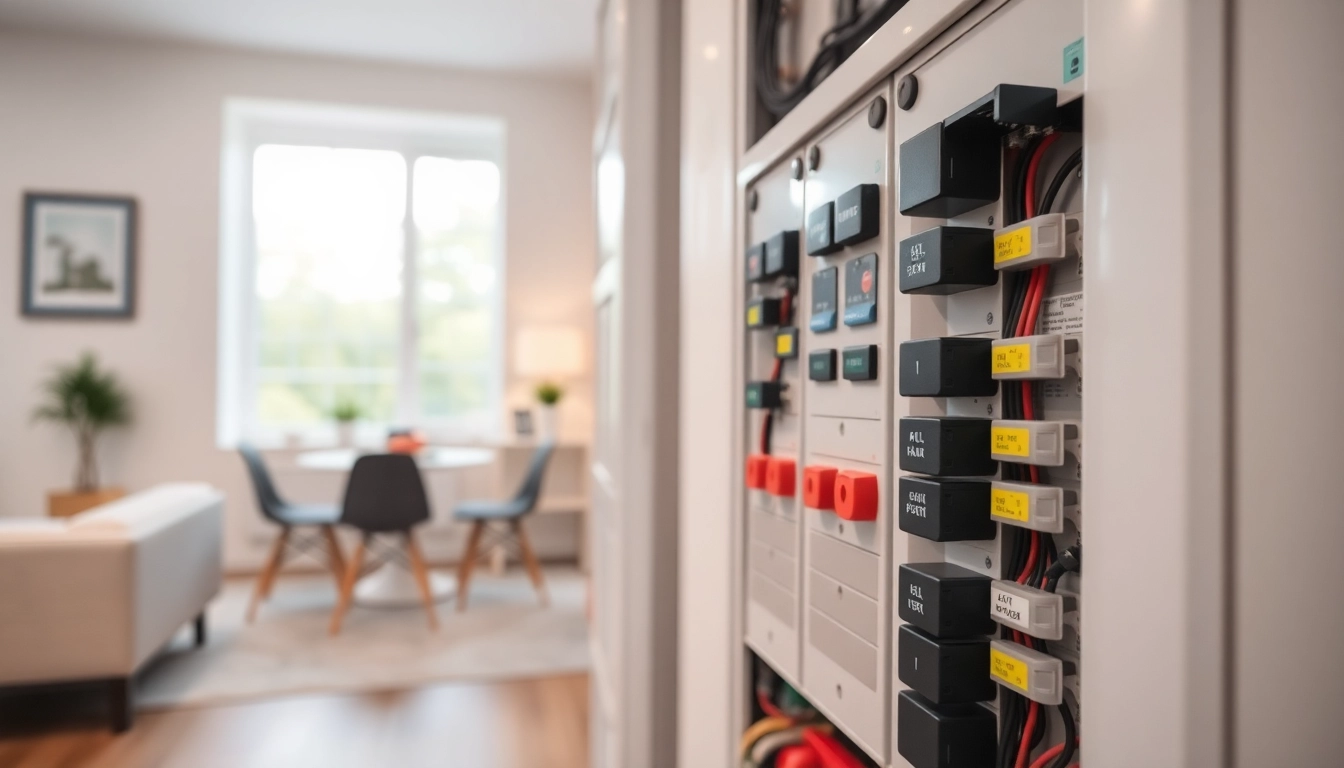Understanding the Basics of Electrical Panels
What is an Electrical Panel?
An electrical panel, often referred to as a breaker box or service panel, is an essential component of your home’s electrical system. The main function of the Electrical Panel is to distribute electricity to various circuits in your home while ensuring safety measures are in place. This includes protecting your home from overloads, short circuits, and electrical fires. Essentially, it acts as the hub where all the electrical circuits originate, allowing you to easily control and manage the electrical flow throughout your home.
Components of an Electrical Panel
An electrical panel consists of several key components:
- Main Breaker: The main breaker controls the flow of electricity into the panel from the utility grid. It also serves as an cutoff switch in case of emergency.
- Branch Circuit Breakers: These smaller breakers manage the current flowing to specific circuits in your home, such as lighting and outlets.
- Bus Bars: Metal bars inside the panel that distribute electrical power to the branch circuits.
- Grounding and Bonding Features: These ensure safety by safely directing excess electricity to the ground, preventing shocks and fires.
- Meter Socket: The location where the utility service meter is attached, providing a means for utility companies to measure electricity usage.
The Importance of Electrical Panels in Your Home
Electrical panels are crucial for both functionality and safety in your home. They not only manage the electrical supply but also protect against potential hazards. Understanding the importance of your electrical panel is essential:
- Safety: Properly functioning panels prevent overloads and short circuits that can lead to fires.
- Efficiency: An upgraded or correctly sized panel can improve the efficiency of your home’s energy usage, potentially lowering electricity bills.
- Convenience: A well-organized electrical panel allows easy access to circuits for maintenance and upgrades without extensive effort.
Signs You Need to Upgrade Your Electrical Panel
Common Warning Signs
Noticing warning signs can indicate that it’s time to upgrade your electrical panel. Some common signs include:
- Flickering Lights: When lights flicker, it often signifies insufficient power being delivered to the circuits.
- Tripped Breakers: Frequent tripping can indicate that your panel cannot handle the load imposed on it.
- Warm or Hot Panel: If your electrical panel feels warm to the touch, it’s a sign of potential overload and a need for immediate evaluation.
- Burning Smells or Sparks: Any burning smell or visible sparks are clear indicators that there may be a serious electrical issue.
Assessing Electrical Capacity Needs
Determining whether you need to upgrade involves assessing how much power your household requires. Consider these factors:
- New Appliances: If you’ve recently added high-energy appliances, you may need an upgrade to accommodate the increased demand.
- Home Renovations: Significant renovations may change your electrical needs, requiring a larger capacity panel.
- Service Size: Typical residential electrical panels have capacities ranging from 100 to 400 amps. Evaluate whether your current panel meets or exceeds these capacity requirements.
Local Codes and Safety Regulations
It’s imperative to ensure that your electrical panel meets local electrical codes and safety regulations. Many municipalities have specific requirements for installation, size, and type of panel that can be used. Not adhering to these regulations can lead to fines, complications during property sales, or increased risks of electrical hazards.
Types of Electrical Panels Available
Standard Circuit Breaker Panels
Standard circuit breaker panels are the most common type found in residential buildings. They come with individual circuit breakers for separate circuits within the home. Their popularity stems from reliability and ease of maintenance. Standard panels are perfect for most home applications, but they might not meet the needs of homes with high energy demands.
Smart Panels and Their Benefits
Smart panels are becoming increasingly popular due to their advanced technology, enabling homeowners to monitor their energy usage in real-time. The benefits of smart panels include:
- Remote Monitoring: You can check your home’s energy usage via smartphone apps.
- Enhanced Safety Features: Advanced sensors can detect overloads and circuit issues before they become severe.
- Energy Management: By tracking energy consumption, homeowners can optimize usage to lower bills.
Cost Comparison of Different Panel Types
The cost of upgrading your electrical panel can vary significantly based on the type selected, location, and complexity of installation. On average:
- Standard circuit breaker panels range from $800 to $1,500.
- Smart panels typically start at $1,500 but can exceed $3,000 depending on features and installation.
- Installation costs can also add to the entire project, ranging from $300 to $1,200 based on the work required.
Upgrading Your Electrical Panel: Step-by-Step
Hiring a Qualified Electrician
It’s crucial to hire a licensed and experienced electrician for your electrical panel upgrade. Check their credentials and ensure they have good reviews or references. A qualified electrician will conduct a thorough evaluation of your current panel, and help you choose the right panel for your needs while ensuring compliance with local codes.
Preparation for Installation
Once you’ve selected an electrician, there are preparations to make for the installation:
- Clear the Area: Ensure the area around your electrical panel is unobstructed for easier access and work.
- Notify Your Electric Company: They may need to disconnect power during the installation process for safety.
- Discuss Expectations: Talk with your electrician about the process, timeline, and any expectations you may have.
Post-Installation Checks and Maintenance Tips
After installing a new panel, follow these steps for maintenance and checks:
- Check Breakers: Regularly inspect breakers to ensure they are not tripping frequently.
- Keep It Dry: Ensure that the panel area remains dry and clean to prevent issues stemming from moisture.
- Schedule Periodic Services: Consider annual check-ups with your electrician to ensure optimal operation.
Maximizing the Efficiency of Your New Electrical Panel
Routine Maintenance Practices
To keep your new electrical panel running efficiently, implement the following routine maintenance practices:
- Inspect Connections: Regularly check that all connections are secure and free from corrosion.
- Test the Breakers: Periodically test all breakers to ensure they trip as intended during overload conditions.
- Clean the Panel: Dust and dirt can interfere with the electrical components; clean the panel regularly with a dry cloth.
Energy-Saving Accessories
Installing energy-saving accessories can enhance the efficiency of your electrical panel and lower your bills:
- Programmable Thermostats: These allow better control over heating and cooling systems.
- Energy Monitors: Devices that track energy usage can help identify high-usage appliances.
- LED Lighting: Replacing incandescent bulbs with LEDs can drastically reduce energy consumption.
Monitoring Electrical Usage
Effective monitoring helps you identify energy wastage and optimize your consumption habits. You can use apps associated with smart panels or standalone energy monitors to:
- Track daily and monthly energy use.
- Identify peak usage times.
- Receive alerts for any unusual spikes in energy use that may indicate issues.



